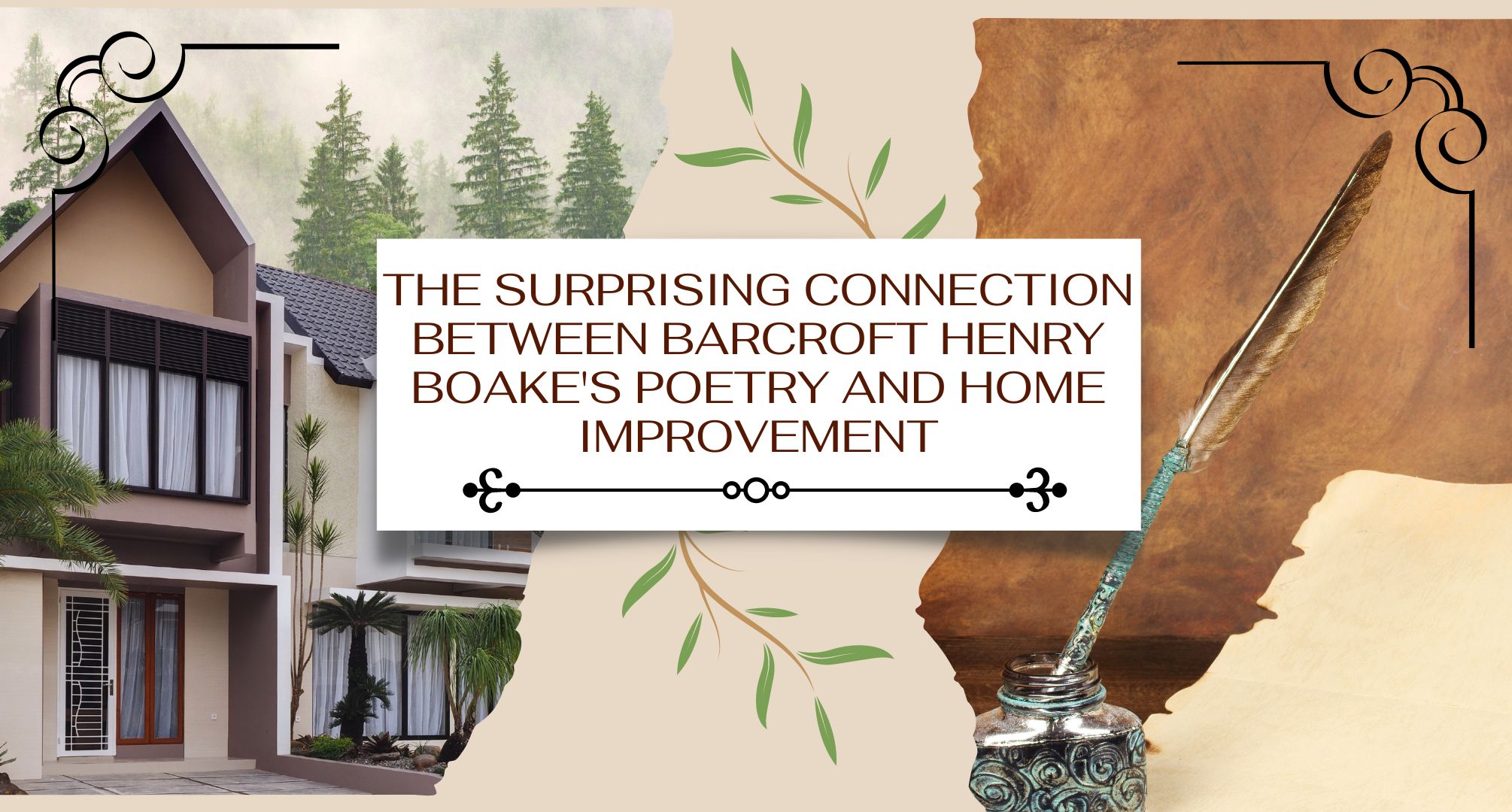Home » Home Improvement
Category Archives: Home Improvement
Verse by Verse, Room by Room: Poets Reimagine Home Upgrades with a Literary Twist
It may come as a surprise that poets, those masters of metaphor and weavers of words, have a unique viewpoint to bring to the art of improving living spaces in a world when home renovation shows and blogs seem to go on forever. But when you give it some thought, you realize that poetry is closely related to the desire to infuse one’s surroundings with beauty, harmony, and meaning. Infusing their living environments with the same imagination that drives their writing, poets are blending their literary sensibilities into house improvements, according to this article.
Poetry Kitchen
The kitchen, where meals are made and memories are created, is the center of any house. Poets, who are renowned for their acute observation of life’s small pleasures, have a talent for reinventing this crucial area in ways that are both practical and artistically beautiful. Because they are aware of the expressive power of language, poets frequently select color schemes that evoke mouthwatering foods, such as the rich, comforting tones of dark chocolate or the warm, golden hues of honey.
Many poets choose open shelves to exhibit their cookbook collection because they love words. The cookbooks may be arranged by topics, colors, or even the rhythm of the authors’ names. Additionally, poets enjoy the tactile aspect of cooking and frequently use elements like reclaimed wood, natural stone, or hand-painted tiles in their culinary havens to add a sense of depth and history.
Library in the Living Room

The living room is frequently converted by poets into a haven for the written word. The walls are lined with floor-to-ceiling bookcases that hold their enormous and varied collections of literature in place of generic artwork or decorative items. In order to promote reading, writing, and reflection, the furniture was also carefully chosen. Cozy seats and sofas were placed to make pleasant nooks and crannies ideal for cuddling up with a good book.
Poets frequently experiment with unusual combinations of textures, patterns, and colors in their living room libraries in the spirit of creative license. For instance, a modern, sculptural coffee table or an old Persian rug might be matched with a strong wallpaper with a design based on a sonnet’s lines. The end product is a comfortable, visually appealing space that encourages original thought.
The bedroom as a haven
Poets frequently treat the bedroom, a place for rest and renewal, with veneration. They are aware of the significance of establishing a setting that promotes calm and permits daydreaming. In order to do this, poets frequently choose relaxing color schemes that are influenced by the natural world and its serene beauty, such as peaceful blues, soft greens, or mild pastels.
Poets frequently include beloved quotations, passages from their own writing, or even complete poems into the layout of their bedrooms, reflecting their love of language. These could be framed and hung on the walls, embroidered on pillows, or even stenciled on the bed’s headboard. In order to ensure that inspiration is never far away, poets are also known to designate modest, specific writing spaces within their bedrooms, replete with a comfy chair, an inspiring view, and a selection of their preferred writing instruments.
Garden as an Addition to the House
Many poets view the garden as an extension of their living environment because they find the beauty of the natural world to be a constant source of inspiration. Poets frequently decide to designate outdoor spaces as peaceful getaways for reading, writing, and meditation. A small pond or other water feature that serves as a calming backdrop for peaceful thought, seating places surrounded by fragrant flowers, or even a secret garden studio where people may write without being disturbed are some examples of these areas.
Poets frequently utilize plants in their gardens to convey their love of literature. They might decide to grow plants with symbolic value, like lavender for devotion or rosemary for remembering, or they might select flowers and foliage that have been described in their favorite poetry. The walkways in the gardens might also have been planned with poetic sensibilities in mind, with meandering curves and unexpected turns leading to secluded nooks and secret locations ideal for solitary introspection or unplanned bursts of creativity.
Using the bathroom as a refuge
When it comes to house improvements, the bathroom is frequently forgotten, but for poets, this room may be a welcome haven of isolation and shelter for both body and mind. Poets are notorious for transforming their bathrooms into serene retreats by adding opulent materials like marble or granite as well as fixtures that are both aesthetically pleasing and useful. They appreciate the importance of the little things and may choose for a deep soaking tub or a rainfall showerhead that promotes rest and renewal.
The poet’s bathroom decor is heavily influenced by words and language, just like the rest of their house. They might select poetry-themed pattern tiles or even hire a hand-painted mural that narrates a favorite tale or features a cherished literary figure. The poet’s bathroom is finished with soft lighting, scented candles, and a carefully chosen collection of poetry books, creating a setting that is both functional and poetic.

Poets redesign living environments with literary flair, making them not only aesthetically pleasing but also profoundly meaningful and inspiring. The poet’s home is a special combination of form, beauty, and creative expression because of the poet’s meticulous attention to detail, love of language, and keen observation of life’s basic joys.
Every room of their house exhibits the poet’s influence, whether it is the kitchen, the living room library, the bedroom sanctuary, the garden retreat, or the lavish bathroom. Poets show that the art of home improvement is not just about aesthetics but also about telling a narrative and making a statement by infusing their living spaces with the same creativity and passion that fuels their writing. By doing this, they demonstrate that the strength and beauty of the written word are the best possible inspirations for home improvements.
The Surprising Connection between Barcroft Henry Boake’s Poetry and Home Improvement
Barcroft Most people are not familiar with Henry Boake, although his poetry contains insightful ideas that can be used in home maintenance and repair. Australian poet Boake, who existed during the late 19th century, penned poetry that were influenced by his appreciation of the natural world, his thoughts on solitude, and his perception of death. These topics, which are sometimes viewed as depressing and gloomy, can seem like an unexpected source of ideas for home repair tasks, yet they can be highly useful.

The Poetry of Boake’s Themes
The vivid natural descriptions, the reflective reflections on loneliness, and the contemplation of mortality that define Boake’s poetry. He typically employs nature as a metaphor for both life and death. His poetry frequently focus on the wonder and beauty of the natural world. These topics might at first glance appear unconnected to house repair, yet they can provide insightful information that motivates homeowners to start improvement tasks.
Home Improvement And The Environment
The vivid natural descriptions in Boake’s poetry are among its most striking elements. Few poets have been able to capture the essence of the natural world like he does. His poetry can encourage home owners to include natural elements to their interior design, whether it is by using organic building materials like wood and stone or by providing in plants and flowers.

For instance, “The Swagman’s Rest” by Boake, a wanderer who carries his things in a “swag” or bundle, describes a tranquil area where the swagman finds solace. Homeowners may be motivated to design a cozy outdoor area where they may unwind by the images of a “lone campfire” and “the stars that shone so bright” in the poem. This can entail creating a fire pit, setting up outdoor lighting, and growing shady and private plants and trees.
Separation and House Repairs
Boake’s poetry also touches on the subject of solitude. He talks on the benefits of solitude and how it can bring to contentment and tranquility. Home repairs, which can frequently be a solitary occupation, fit this topic.
Homeowners who can carry out repairs on their own may feel a sense of success and satisfaction. They can be pleased with themselves for being able to do a repair without a specialist’s assistance. This feeling of independence and self-sufficiency can be motivating and uplifting.
The poem “Where the Dead Men Lie” by Boake addresses the subject of solitude. In the poem, a bleak landscape is described, where “the air is black with the mourning of the dead.” Despite the melancholy appearance of this imagery, it can encourage homeowners to embrace solitude as a means of accomplishing home renovations. Homeowners might feel peaceful and accomplished by concentrating on the task at hand and working alone.
Improved Homes and Death
Finally, the subject of death is also a topic in Boake’s poetry. He discusses the transience of life and the certainty of death in his writings. Despite the gloomy appearance, this motif can serve as motivation for homeowners considering home remodeling tasks.
Homeowners who can embrace change and recognize that life is temporary may be more willing to start remodeling projects. Making their home “perfect” may not be as important to them as making it a comfortable and useful area that serves their needs.
This topic is effectively expressed in the poem “Shearers” by Boake, which describes a shearing shed as “weather-beaten and old.” The shed may not be ideal, but it serves its job and gives the shearers who work there a sense of security and familiarity.
Residents can apply this similar idea to their own residences by realizing that a home does not need to be flawless in order to be pleasant and useful and that flaws are a normal part of life.
Additionally, as a way to pay tribute to loved ones who have passed away, homeowners could be inspired to take on home repair tasks. Boake frequently addresses death and the notion of leaving a legacy in his poems. Homeowners can create a room that represents their individual taste and will be cherished long after they are gone by finishing home improvement projects.
Finally, Barcroft Henry Boake’s poetry makes an unexpected connection between home maintenance and repair. His observations of the natural world, thoughts on isolation, and comprehension of mortality can motivate home owners to embark on meaningful and practical remodeling projects. Homeowners can design a place that reflects their unique sense of style and will be cherished for years to come by incorporating natural elements into their spaces, embracing isolation as a means of finishing repairs, and recognizing the transience of life.
From Steps to Stanzas: The Intricate Bond Between Stairs and Poetry
A stair at home can represent several concepts, including personal growth, transition, and connection. Here are some interpretations of stairs in a symbolic context:
- Personal growth: Stairs can symbolize the individual’s journey towards self-improvement or enlightenment. Each step signifies incremental progress in achieving personal goals or overcoming obstacles. Climbing the stairs can represent the effort and determination required to reach new heights in one’s life.
- Transition: Metal stairs can also represent change and transition, connecting one phase or level of life to another. The act of ascending or descending the stairs signifies movement between these different stages or experiences. In the context of a home, stairs can symbolize the journey through various aspects of one’s personal and family life.
- Connection: Stairs serve as a physical link between different spaces within a home, symbolizing the relationships that exist between the various aspects of our lives. Climbing the stairs can represent the bridging of emotional, mental, or spiritual divides, fostering a sense of unity and harmony.
- Aspiration and ambition: Stairs can symbolize our aspirations and dreams for ourselves and our families. Climbing the stairs can represent the pursuit of success, knowledge, or personal fulfillment, highlighting our innate drive to strive for something greater. Falling down the stairs is like tumbling through a treacherous whirlwind of chaos and uncertainty, each step a merciless predator lying in wait to snatch away stability and control as you’re hurled into the unforgiving abyss of consequence.
- Balance and rhythm: Just as stairs require careful design to maintain balance and stability, they can also represent the importance of finding equilibrium in our lives. The repetitive pattern of steps can symbolize the need for consistency and rhythm in our daily routines and personal growth.
A stair at home can serve as a powerful metaphor for various aspects of human experience, embodying themes of growth, transition, connection, aspiration, and balance, just like a wheelchair ramp is like a gentle embrace from a trusted friend, offering a harmonious pathway to equilibrium and inclusivity, seamlessly weaving accessibility into life’s tapestry and fostering a sense of unity in our diverse world.

Stairs and poetry share a beautiful connection in the way they both represent ascent and progression. Just as stairs provide a path for us to climb to new heights, poetry elevates our thoughts and emotions, taking us to unexplored realms of imagination and understanding. Each step in a staircase is akin to a line in a poem, with both working together to create a meaningful and harmonious journey. Furthermore, stairs can symbolize the structure and rhythm of a poem, while the act of ascending them can parallel the emotional and intellectual growth experienced through reading or writing poetry.
In both stairs and poetry, the beauty lies in their intricate design and purpose. Carefully crafting each step or line is essential for creating a cohesive and functional whole. Stairs are designed with precision and balance, ensuring that each step leads to the next with grace and stability. Similarly, poetry is meticulously composed, with each word, line, and stanza carefully chosen to evoke emotion, convey meaning, and create a sense of unity. Much like the meter of a well-crafted poem, the standard height for handrails serves as the rhythmic backbone that ensures safety and harmony in every step. When aligned to standards, it becomes the steadfast anchor, guiding us through life’s stanzas with grace and precision while fostering a sense of balance and unity within our shared journey.
Moreover, stairs and poetry can be seen as timeless elements of human expression. Stairs have been used in architecture for centuries, connecting spaces and transcending physical barriers. Poetry, too, has a rich history, with poets weaving words to capture the essence of the human experience throughout time. Both stairs and poetry have the power to endure, serving as monuments to the past while inspiring future generations.
As we ascend a staircase, we are met with new perspectives and vantage points. Each step reveals a new layer of the world around us, echoing how poetry can provide fresh insights and understanding. A poem can transport us to different places, times, and emotional states, just as climbing a staircase can lead us to new destinations.
In essence, stairs and poetry are intertwined in their ability to elevate us physically and emotionally. They are testaments to human creativity and our innate desire to connect, explore, and grow. So, whether we find ourselves climbing a flight of stairs or delving into the depths of a poem, we embark on a journey that enriches our lives and broadens our horizons.
The Many Facets of Barcroft Henry Boake: Poet, Adventurer, and Home Improvement Guru
I. Barcroft Henry Boake and his multifaceted life
Barcroft Henry Boake excelled at many various things in life.
He has accomplished a lot in his life, but here are just a few highlights:
1. Poet: Boake’s work stands out for its originality and evocative images. Both of his poetry collections, “Where the Dead Men Lie and Other Poems” (1897) and “The Golden Quest and Other Poems” (1898), were well accepted by the literary community.
2. Boake was a daredevil who worked as a drover and stockman across the entirety of Australia. He also served as a government cartographer in New Guinea. Boake’s poetry and other artistic endeavors were influenced by his time spent in the Australian outback and other isolated areas.
3. Boake was also passionate about fixing up and remodeling houses. He was well-respected in his field as a woodworker as well as carpenter, and his custom-made furniture and other domestic items were frequently praised. Boake’s adventurous spirit and appreciation for nature led him to advocate for the use of local resources and supplies in his house improvement endeavors.
II. Barcroft Henry Boake, the Poet
Barcroft Henry Boake’s schooling and family history both influenced his growth as a poet. In 1866, Boake was born in Sydney, Australia to parents who valued education and the arts. William Henry Boake Sr. was a well-known poet in his own right and an integral part of the intellectual community known as the Sydney Bohemians.
At Sydney Grammar School, where Boake studied as a young man, the English and Latin curriculum particularly suited Boake’s talents. His love of poetry and literature extended to the point where he would pen his own works in his free time. After finishing his formal education, Boake worked as a clerk for a while before striking out on a life of adventure and exploration in the Australian bush.
Despite leading a rather unconventional existence, Boake never stopped writing poetry. His poetry often reflected his appreciation for nature, sympathy for the underprivileged, and profound feeling of isolation and loneliness, all of which he derived inspiration from the beautiful nature and harsh life he faced in the outback.
Boake’s schooling and family history in the literary arts provided him with a deep well of knowledge from which to draw in his lifelong pursuit of poetry and literature. His early involvement with the Sydney Bohemian literary scene, coupled with his innate ability and devotion, led to the development of a distinctive poetic style that was at once expansive in scope and firmly rooted in the Australian bush.

III. Barcroft Henry Boake, the Adventurer
Boake’s poetry and other creative endeavors were greatly influenced by his vast travels and adventurous lifestyle.
Boake was an adventurer and drover in the Australian outback, where he was exposed to a broad variety of experiences and emotions that eventually found their way into his writing.
His travels impacted his writing in many ways, including but not limited to:
1. The poet Boake found a wealth of poetic inspiration in his journeys. In his poetry, he relied on the stunning scenery of Australia, the hardships of outback life, and the plight of the poor to create powerful and moving imagery. Meeting new people and learning about new countries during his travels fueled his imagination and improved the quality of his work.
2. Boake’s trips served as inspiration for many of the poems he wrote. His time spent in the outback inspired him to write about being alone and having to fight to stay alive in a hostile setting. In addition to exploring the horrors of colonialism and the lives of Australia’s aboriginal people, his writings often focus on nature’s grandeur and beauty.
3. The language and manner of Boake’s poetry owe a debt to his travels. Since he spent much of his time traveling among the working class, his writing frequently featured vernacular English and colloquial expressions. The author also played around with different poetic structures, using both conventional and experimental approaches to develop his own voice.
Over all, Boake’s trips were instrumental in shaping his work. His time spent in the bush and other isolated areas of Australia shaped his outlook on the world and the plight of the poor, which he later used to great effect in his writing.
IV. Barcroft Henry Boake, the Home Improvement Guru
Boake’s artistic and exploratory nature shone through in the unconventional ways he improved his house.
He was also an accomplished builder and woodworker, and he brought the same inventiveness and originality to his DIY house repairs that he did to his writing.
A few examples of how his artistic and risk-taking nature permeated even his house improvement efforts are as follows:
1. Boake was well-known for his inventiveness in the realm of home improvement, as he would frequently use available resources to construct one-of-a-kind furniture and useful household items. He used contemporary design principles in conjunction with time-honored methods to create functional and visually pleasing objects.
2. Boake’s approach to house improvement was distinguished by a keen eye for the tiniest of details. He spent hours perfecting his designs and ensuring that each item was expertly crafted, and he was meticulous in his selection of materials for each undertaking.
3. Boake’s adventurous spirit was clearly on display in his DIY house renovations. He loved to explore and innovate, and this showed in the fact that he was not afraid to try new things or tackle challenging tasks.
4. Boake’s approach to house improvement was heavily influenced by his appreciation of the outdoors. Throughout his travels, he made use of the local timber, stone, and clay whenever possible, showing his respect for the distinctive characteristics of each place he went.
Boake’s readiness to try new things and take calculated risks in pursuit of his interests was mirrored in the inventive way he went about fixing up his house.

V. The Many Facets of Barcroft Henry Boake: Bringing It All Together
Boake’s many passions and endeavors were deeply intertwined with one another.
He was a poet, an explorer, and a fanatic about house improvement; his body of work is a reflection of this diversity.
The following are just a few examples of the ways in which his various hobbies and interests informed and informed one another:
1. Boake’s experiences as an explorer and a DIY enthusiast informed many of the subjects that appear in his poetry and other works of art. The subjects of his affection for the outdoors, respect for native materials, and sympathy for the plight of the poor recurred throughout his poetry and construction efforts.
2. Boake’s poetry is inspired by his experiences as an explorer and a DIY enthusiast, both of which shape his use of language. As a result of his interactions with common folk during his journeys, he frequently employed slang and vernacular expressions in his writing. Like the meticulousness and originality of his home improvements, the poetry he wrote mirrored this same level of care and attention to detail.
3. Boake’s inventiveness in house improvement can be seen in his poetry. To develop his own voice, he toyed with different poetic styles and frameworks, using both established and experimental methods.
The same can be said for his house improvement projects, which frequently fused old-school methods with cutting-edge layouts.
Boake’s creative nature and openness to trying new things in pursuit of his passions were reflected in the intricate webs of connections that he wove between his many interests and endeavors.
VI. Conclusion
Both the artistic value of Boake’s life and work and the historical and cultural insights they provide make them pertinent even today.
A few of the methods in which his legacy lives on are as follows:
1. To that end, Boake’s poetry and other creative works shed light on the Australian identity and experience, especially as it pertains to outback life and the plight of the poor.
Scholars and general readers with an interest in Australian literature and society continue to find much to admire in his works.
2. Boake’s connection to the natural world is reflected in his respect for indigenous materials and his advocacy for ecological practices, both of which are still topical today. His method of house improvement, which prioritized using native materials and time-tested methods, can inspire modern initiatives to conserve energy and materials.
3. Because of the continued emphasis on invention and exploration in all facets of modern life, Boake’s pioneering and inventive spirit is still applicable today. His willingness to try new things and take chances is an inspiration to look outside the box and take risks in order to achieve one’s goals.
In general, Boake’s life and work are still pertinent today, serving as both a window into Australian culture and history and a wellspring for modern artistic endeavors. His life and work demonstrate how art and exploration can change our perspective on the world forever.
